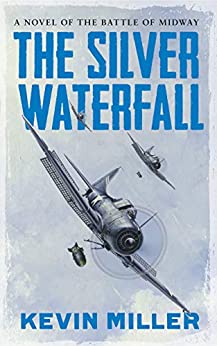
Reviewed by David F, Winkler, Ph.D.
Since its inception, the Naval Historical Foundation book review program has welcomed historical fiction submissions, recognizing that fictional writers, released from the constraints of demonstrating documented sources, can sometimes convey a better sense of what actually happened to a broader audience. Such is the case with The Silver Waterfall, Kevin Miller’s first attempt at historical fiction. A retired Navy captain, Miller had earned his wings of gold and first flew A-7 Corsairs before switching to the cockpit of an F/A-18 Hornet. I first met Miller when he had command of VFA-105 embarked in Enterprise in the aftermath of strikes his squadron made against Iraq in December 1998 – an operation called Desert Fox. We later crossed paths when he was Chief Operating Officer of the Naval Aviation Museum Foundation. Since then he has taken to writing. Following in the wake of Tom Clancy in the techno-thriller genre, he has published a trio of contemporary novels drawing on his experience as a naval aviator that have built quite the following.
Turning to the past, Miller now aims to replicate for Midway what Michael Shaara had accomplished for Gettysburg, A gifted story-teller, Miller’s depiction of the banter and emotions felt by the participants of the battle – mostly aviators – seems very credible. While he drew on his own time in the cockpit piloting Navy attack jets to relate to the reader the experience of diving on a Japanese carrier in a SBD Dauntless, what’s more evident is he spent much time with many of the veterans. Furthermore, during his tenure at the National Naval Aviation Museum in Pensacola, Miller got to know their aircraft.
Like Gettysburg, Midway is a three-day battle. For Shaara the battle climaxes on the third day with George Pickett’s charge through the wheat fields which is turned back after bloody hand-to-hand combat. Midway doesn’t play out as nicely for Miller. The climax of the battle occurs on the first day when “The Silver Waterfall” descends on Kido Butai to successfully takeout three of the four Japanese carriers supporting the planned seizure of Midway.
Miller handled the challenge of keeping the reader engaged over the following two days by recreating tensions and turmoil that where known to be present between Raymond Spruance, his chief of staff Miles Browning, and the carrier, air group, and squadron commanders. Miller makes it abundantly clear that in the American destruction of four of the Imperial Japanese Navy’s finest flattops, that Hornet did not cover itself in glory as its fighter and dive bomber squadrons missed out on the action of June 4 to leave Torpedo Squadron 8 to attack alone and get annihilated.
Indeed, Miller’s depiction of the discussions on the bridges of Japanese and American flagships make this book worthy reading material for case studies on command decision making.
What could make the book more suitable for such use is if Miller provided more explanatory footnotes. Because I’ve read many takes on the battle, including Craig Symonds most recent study, The Battle of Midway (2011), I understood the “backstory.” Readers unfamiliar with the battle do not. Miller provides some explanatory notes such as the Mogami-Mukuma collision, but he could have further enhanced his work had he chose to include biographical notes about his featured individuals, factoids about the ships and aircraft involved in the engagement, and additional aspects about the battle that could not be practically included in the narrative.
Overall, did Miller accomplish do for Midway what Shaara did for Gettysburg. I would have to answer with a resounding “Yes!”
Kevin Miller. The Silver Waterfall: A Novel of the Battle of Midway. Braveship Books, Los Angeles CA. 2020
Dr. David F. Winkler is the Staff Historian for the Naval Historical Foundation and the 2020-2021 Charles Lindbergh Chair of Aerospace History at the Smithian Institute.
Purchase your copy today! amzn.to/2DXsIiR

